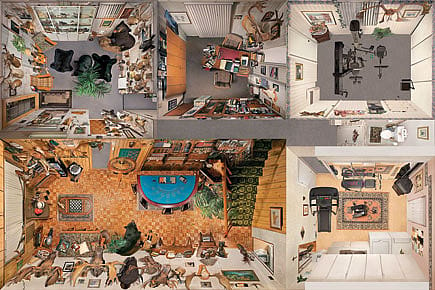A Cartographer among Photographers

Alain Paiement uses a technique called mapping to put together hundreds of shots that offer an artistic aerial view of life
Almost sixty years ago, American photographer Alfred Newman pioneered 'environmental portraiture'—the idea that a picture of an individual should be taken within a carefully-controlled setting, within a space where the objects surrounding the subject should add or help explain his or her personality. An author at a writing desk, for example, a musician within a recording studio, a politician at a podium. Newman was also known for his elaborate abstract still-life images. A photograph, for Newman, needed to be exquisitely crafted, leading him to famously say (at a time when the 'truth-telling' capacity of the medium was in much debate): "Photography, as we all know, is not real at all. It is an illusion of reality with which we create our own private world." In the bulk of his work, Canadian photographer Alain Paiement takes it a few steps further.
Using the principles of 'mapping', the artist invites the viewer to gaze into an apartment, into a store, into a street filled with demonstrators. He does this literally by taking hundreds of multiple aerial view images and digitally placing them together, creating everyday spaces rendered almost magical by the way they have been photographed. Paiement, like Newman, not only 'creates his own world' but also constructs a particular vision, an unusual way of looking at people, rooms and mundane daily things. We hover God-like above this landscape that is all at once distant and familiar. His work is less like a photographer's and more like a cartographer's, a map-maker obsessed with revealing the order of spaces and things, the relationship between the living and the inanimate. Paiement pushes the idea of a photographer as archivist, geographer and anthropologist.
Just as Newman was the master of constructing a certain ambience around his subject, Paiement also fills his photographed spaces with tell-tale objects. His subject is sometimes an individual; the Shower Series (1998-2004), for example, captures, from above, people taking a shower, sparsely-surrounded by bathroom toiletries. The series is one of single shots. The photographs offer a wholly-voyeuristic experience, yet the figures are artfully shot, and in their nudity, conceal more than they reveal.
Sometimes, Paiement's subjects are apartment rooms, bared before you like a modern, grown-up doll house. Here, architecture also comes into play, not just with the blueprint layout of the images, but also with specific design element details—the sweep of a spiral wrought iron stairway in From Where I Live, a baroque wall pattern in Arrangements According to Nature, Woman's Floor. The pictures, at a certain level, function as cryptic puzzles, which you must figure out by gazing at them long and hard. Only then, perhaps, would you notice the occupants, seemingly caught doing the most mundane or intimate things—like reading a book, sitting at a computer or taking a tub bath. Similarly, the household objects and personal belongings around them also serve to build an (imaginary?) picture of their lives. The According to Nature duo of images do so extremely well, even if they are both cheeky, exaggerated portrayals of the 'differences' between the sexes—the 'Woman's Floor' is a depiction of an ultra-feminine Rococo-style space decorated with ornate furniture, florid carpets and drapery and stylish light fixtures. Potted plants dot the room. The 'Hunter's Floor', on the other hand, looks like a posh abattoir with an overwhelmingly large number of shot animal heads on the wall and animal skin carpets on the floor.
From the home, Paiement moves out into the city, capturing carefully constructed slices of Montreal life. And this is where Paiement's mapping technique comes most forcefully into play. In Pane Mundial, he cleverly uses a long wide-angle image to lure the viewer not only into the confines of a busy bakery but also out into the street, with traffic and a group of protesters on the pavement. If you look carefully, you'll see elements from other images also within the frame, echoing how our personal and public spaces, and lives, are closely intertwined.
While Newman photographed famous people—John F Kennedy, Audrey Hepburn, Pablo Picasso and Arthur Miller, among others—Paiement constructs for us the lives of nameless, faceless figures, whose stories can be pieced patchily by what the artist chooses to place around them. His exceptional skill lies in the fact that we are intrigued, challenged, sometimes even moved by them, drawn ineluctably by the lives of others.
Surfacing Over There shows at Matthieu Foss Gallery till 2 April, 2011
